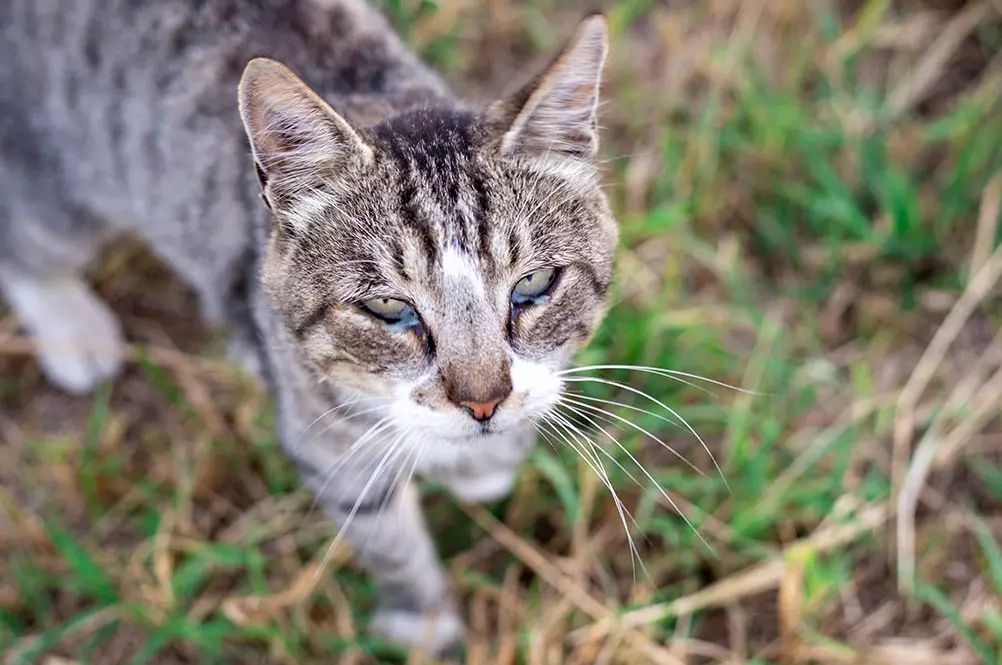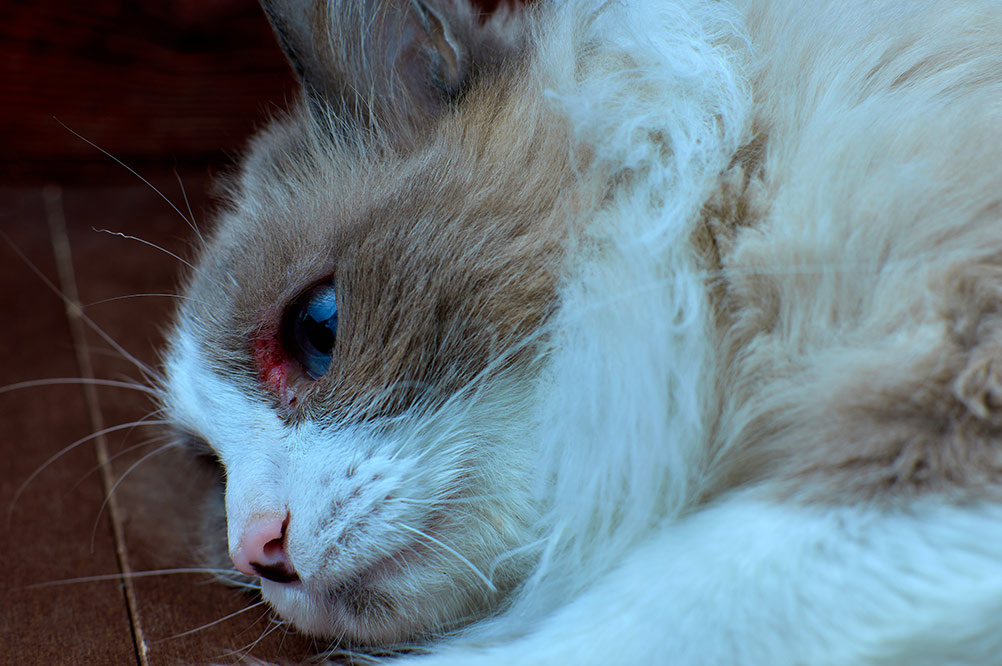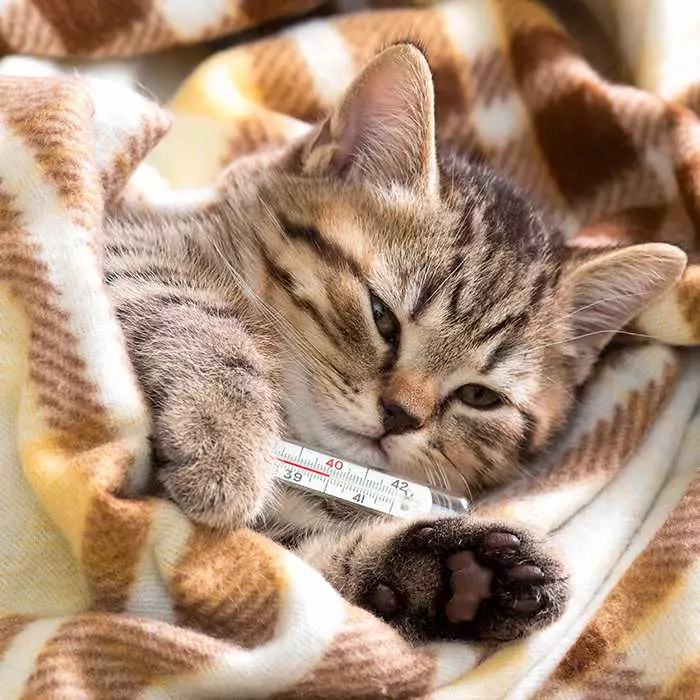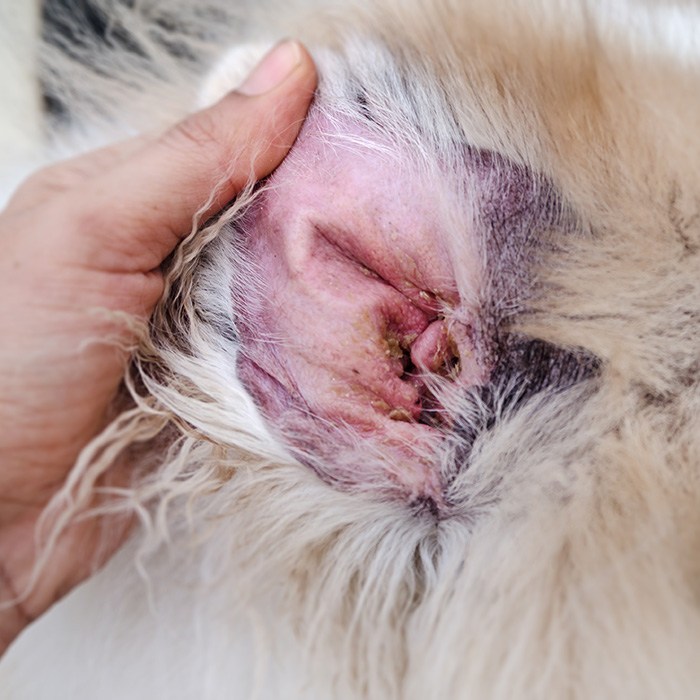Allergies in cats – What you need to know
What is an allergy?
An allergy occurs in a cat when their immune system becomes overly sensitive to a particular substance and regards it as dangerous. Even though the substance – or allergen – is usually common in most environments and is harmless to most animals, this cat will have an extreme reaction to it. As their body tries to rid itself of the ‘dangerous’ substance, their immune system over-produces antibodies, resulting in an inflammatory response, which can cause a wide variety of symptoms.

All cats can be at risk of developing allergies, and some will acquire multiple allergies.
Many substances can become allergens, including certain foods, grooming products, medications, chemicals, pollen and flea bites. These substances are either inhaled, ingested or come into contact with the skin.
Allergies in cats are often pruritic, meaning that they cause extreme itchiness and provoke the desire to scratch.
Allergies are often the underlying cause of recurring bacterial and yeast infections of the skin and/or ears, which arise from the from the excessive scratching. Such infections, though secondary to the allergy, can increase the cat’s level of itching and perpetuate the scratching.
Different types of allergies affecting cats
Severe skin reactions to an allergen, also called atopy or atopic dermatitis, are very common in cats. In fact, allergic skin disease and its secondary infections dominates small animal practice. Affected cats often scratch their skin and develop small scabs across the body or larger scabs in one or more areas; they may also lose patches of hair.
Allergic rhinitis in cats is a usually seasonal allergy caused by pollen exposure, although it can also be a nonseasonal allergy caused by exposure to mould, dander, bedding or feeds. The usual symptoms are a watery nasal discharge and sneezing. It is less common in cats than in people.
Although airborne allergens usually affect the skin, they also cause inflammation of the nasal passages (rhinitis) and asthma in around 15% of animals.
Allergic asthma occurs frequently in cats, typically occurring in summer and in some cats can be triggered by going outdoors. However, indoor cats can also get asthma, often from reaction to dust mite allergens. Asthma attacks in cats can be fleeting and mild or they can be protracted and severe.
Allergic bronchiolitis, an inflammation of the lower portion (bronchioles) of the airway, is also common in cats. Typical signs are coughing, wheezing, and some difficulty breathing, and it may be mistaken for other conditions such as allergic asthma or lungworm disease. The offending allergen usually is not identified.
Studies have shown that flea allergy and environmental allergies to inhaled substances are the most common allergies in cats, followed by food allergies.
Symptoms of allergies in cats
Symptoms of allergic reactions in cats typically include dermatological signs such as itchy skin, hair loss and excessive scratching.
While itchy, irritating skin problems are also the most common symptoms of a food allergy, around 10 percent to 15 percent of affected cats also exhibit gastrointestinal symptoms, such as vomiting and diarrhoea. In such cases, the first, and in some cases only, symptom of a food allergy may be vomiting that occurs within an hour or two of eating.
Severe cases of food allergy are often characterised by persistent scratching, diarrhoea, weight loss, skin lesions and poor coat condition. These symptoms of allergic reactions in cats only become evident after an extended period of time (months or longer) as the immune system response intensifies.

Other common symptoms of the various allergies affecting cats may include:
- Sneezing, wheezing
- Coughing (if the cat has asthma)
- Itchy skin, increased scratching
- Itchy, runny eyes
- Itchy back or base of tail (mostly seen in flea allergies)
- Itchy ears, ear infections, swollen ears
- Snoring (caused by an inflamed throat)
- Paw chewing, swollen paws
- Scratching the head or neck (symptom of food allergy)
- Scratching the ears
- Licking or chewing the fur
- Skin lesions
- Red, oozing bald patches
- Rashes
Causes of allergies in cats
Insect Bites
Cats can have an allergy to insect bites, and particularly to flea bites. In fact, flea allergic dermatitis is the most common skin disease in cats.
Flea allergy is a reaction to the flea’s saliva, and it only takes a few bites to trigger intense itching that can last for 2 to 3 weeks. Just because you haven’t seen any fleas on your cat, don’t assume there aren’t any – your cat’s intensive scratching or licking may have displaced them. In warmer climates and indoor environments, fleas can survive year-round.
Feline mosquito hypersensitivity is an allergic reaction to mosquito bites which causes an ulcerative and crusted dermatitis of the pinnae and nose, and less commonly the footpads, eyelids, chin, and lips.
Food allergies in cats
Some cats develop allergies to certain foods; however, there is some controversy about how common food allergy is in dogs and cats.
An allergic reaction in cats caused by food can occur at any age and requires time to develop, with most animals having eaten the offending food for years with no trouble (contrary to common belief, it is not a new food that the cat is responding adversely to).
Various food proteins, carbohydrates, preservatives, flavourings or colourings can all be potential food allergens, although proteins are the most common culprits in cats, with beef, dairy and fish being the top three.
Food allergy is one of the itchiest conditions to occur in cats. While the resulting inflammation often targets the gastrointestinal (GI) tract, causing vomiting and diarrhoea, in cats it is the skin that often suffers the most, with debilitating itching occurring around the face or neck, resulting in scabs and hair loss.
Environmental substances
Exposure to a variety of commonplace and otherwise harmless substances in the environment can result in an allergic reaction in cats, including:
- The pollens of weeds, grasses and trees
- House dust mites
- Mould spores
- Plants
- Cleaning products
- Fabrics and other materials such as carpet
- Rubber and plastic materials such as feeding and watering bowls, collars
- Cigarette smoke
- Veterinary drugs
- Cleaning products
- Flea-control products
- Perfumes

How are cat allergies diagnosed?
If you suspect that your cat has an allergy, it is important that you visit your veterinarian. After taking a complete history and conducting a thorough physical examination, your vet may suspect the cause of the allergic reaction.
For example, if the itching is seasonal, an environmental allergen is more likely to be the problem, whereas if vomiting and diarrhoea frequently occur, a food allergen is more likely.
For accurate diagnosis of the underlying cause of the allergy, the vet may recommend skin or blood tests and/or a special elimination diet. Diagnosis of the specific underlying cause may reduce the need for medications or enable your vet to prescribe more specific and targeted treatments.

Can allergies be treated without diagnostic testing?
Sometimes. Because flea allergy is so common, many vets recommend instituting complete flea control before proceeding with allergy testing. In many cases, the symptoms will clear up and no further action is required.
If 100% flea control is not effective, your vet may simply prescribe anti-allergy medications that can help to reduce itching and other symptoms. However, without addressing the underlying cause of the allergy, the itching will return when the medication is stopped. Unfortunately, long-term use of some anti-allergy medications, such as steroids, can lead to other health issues, so they cannot be taken indefinitely.
Allergy testing in cats
Your cat may require an allergy test if she has excessively itchy or irritated skin. Allergy testing is used to measure the levels of antibodies produced by the immune system, to identify the allergen responsible for the reaction, and to formulate specific immunotherapy that targets the offending allergen.
The preferred test is an intradermal skin test, as blood allergy tests are not considered as reliable.
Food allergy testing
There are currently no accurate blood or skin tests to determine if your cat has a food allergy. In a true food allergy, proteins are the major allergens that incite the cat’s immune system. Blood allergy tests can detect antibodies for certain proteins, but this does not necessarily mean the cat is allergic to that protein – it may simply mean that she has eaten that type of protein before. The only way to diagnose a food allergy is by means of a food trial, which entails exclusively feeding your cat a special diet for around 12 weeks. There are two types of food allergy trials: novel protein and hydrolysed protein (protein-rich foods such as beef, dairy and fish being the primary culprits in food allergies).
The traditional approach is the novel protein diet, which excludes all potential allergy-causing substances and contains only a single protein source and single carbohydrate source that your cat has never eaten before (examples are venison and potato, fish and potato, egg and rice, duck and pea, and even kangaroo). The rationale is that it typically takes years to become allergic to a food protein, so the cat should not be allergic to something new. Once the allergy symptoms resolve, a food challenge is performed by reintroducing old foods one by one and watching for a return of the symptoms. If this occurs, a diagnosis of food allergy is confirmed.
A more recent approach to testing involves using a special diet made from hydrolysed proteins. This means that a conventional protein source is used but the protein is broken down into molecules too small trigger an immune system response. Some hydrolysed diets are commercially available, while others can be purchased only from your vet under prescription; discuss with your vet which is best for your cat. The cat consumes only the hydrolysed diet for 6 to 8 weeks, after which the normal diet is resumed; itching generally recommences within 14 days if a food allergy was truly the reason for the itchy skin.
Treatment for allergies in cats
 Unfortunately, there is no cure for an allergy, and it is usually a life-long problem. The best way to treat allergies is to remove the offending allergens from the environment or avoiding exposure to them; however, this is not always possible. The aim of treatment is to control the allergy and improve the quality of life for both you and your cat.
Unfortunately, there is no cure for an allergy, and it is usually a life-long problem. The best way to treat allergies is to remove the offending allergens from the environment or avoiding exposure to them; however, this is not always possible. The aim of treatment is to control the allergy and improve the quality of life for both you and your cat.
There are a variety of treatments to soothe itchy skin and clear up infections associated with allergies. Medication is sometimes prescribed for cats in case certain allergens cannot be removed from the environment. Medications include cortisone, steroids or allergy injections for airborne pollens, antihistamines as a preventative and flea prevention products.
Treatment for environmental allergens
If an inhalant allergy to something in the environment is the cause, try to remove the allergen as much as practically possible. Symptomatic relief by using medication, baths with specific shampoos, or allergy shots may also be necessary.
If the allergens cannot be removed from the environment, your vet may recommend the following:
- Steroids, to help control an allergy to airborne pollens.
- Anti-allergy injections, which treat the allergy itself instead of just masking the itch.
- Antihistamines, which can be used preventatively, before your cat is exposed to the allergen.
- Fatty acid supplements, to help relieve your cat’s itchy skin.
- Using a dust-free, unscented litter (your cat might have an allergy to the chemicals in scented litter).
- Cleaning your cat’s bedding once a week and vacuuming your home at least twice weekly – this includes rugs, curtains and any other materials that gather dust.
- Bathing your cat one or two times per week, to help relieve itching and remove environmental allergens and pollens from her skin.
- Special shampoo, to help prevent skin infection, which occurs commonly in cats with allergies (however, frequent bathing can also dry out skin).
Food allergy treatment
Many cats diagnosed with a food allergy will require a home-cooked diet, but this must be done in consultation with your vet as it requires a special protein and careful food balancing.
Special allergy diets are available commercially, but again consult your vet for specific recommendations – unfortunately, even if the ingredient list looks appropriate, many off-the-shelf products are mislabelled and/or potentially include allergenic ingredients that are not included on the label. Testing has revealed that some commercial cat foods contain additional proteins – probably contaminants from prior batches in the pet food factory. For these reasons, many vets will recommend prescription diets for food allergies that are manufactured under much stricter quality controls.
Flea allergy treatment
For cats with flea allergy, 100% flea control is essential for remaining symptom-free. Unfortunately, in warm climates or in our homes, fleas may survive in low numbers all-year-round; therefore, for most allergic cats, year-round flea treatment is an important part of reducing itchiness.
Prevention is the best treatment for fleas, and all the cats – and dogs – in your home need to be treated – an outdoor pet can carry fleas inside to indoor pets. See your vet for advice about the best flea control products for both your cat and the environment.
Summary
Allergies are a common cause of skin conditions in cats, with most cats with allergies licking or chewing their fur in an attempt to relieve their excessive itching.
The major types of allergies in cats are flea allergy (the most common skin disease in cats), food allergy (hypersensitivity to certain foods) and allergies to various environmental substances, such as pollens, grass, dust mites and chemicals. Allergies are often the cause of recurring skin and ear infections that further increase the level of itching.
Unfortunately, once they set it, allergies are usually a life-long problem without a cure. However, with lifestyle changes, medication or a special diet ,allergies can be managed and itching can be reduced. It’s best to consult your vet in order to get a specific diagnosis, as well as recommendations for the most effective treatment options.
Facts on allergies in cats
- Allergens are substances that, when inhaled or absorbed through the skin, respiratory tract, or gastrointestinal tract, stimulate antibody production. When an animal encounters these allergens again, more antibodies are produced, triggering histamine release and inflammation.
- There is no specific breed or age range that food allergies target – however, certain breeds may be more susceptible to food allergies than others, for e.g. Siamese and Siamese crosses may have a higher risk of food allergies than other breeds.
- Purebred cats are more likely to be affected by airborne allergens than domestic shorthair cats.
- One study showed that most cats will show signs of food allergies before they are 2 years of age. While kittens with food allergies may grow out of them, older animals may need special and restricted diets for the rest of their lives.
- Anaphylactic shock is a rare, life-threatening, immediate allergic reaction to food, an injection, or an insect sting. The most common signs occur within seconds to minutes after exposure to the antigen – these include severe respiratory distress, very fast heart rate, weak pulse, very pale gums, cold limbs and the sudden onset of diarrhoea, vomiting, excessive drooling, excitement, incoordination, shock, seizures, coma, and death.
- Hives (urticaria) and areas of swelling are caused by allergic reactions to environmental or ingested allergens such as drugs, vaccines, chemicals, food, insect bites, or even sunlight. Causing small bumps to appear on the skin, hives generally develop within 20 minutes of being exposed to the allergen. Hives are the least severe type of anaphylactic reaction and typically go away by themselves once the cause of the allergic reaction is removed or passes through the body.
Bow Wow Meow Pet Insurance can help protect you and your cat should an unexpected trip to the vet occur.
-
Find out more about our cat insurance options
-
Get an online pet insurance quote
Bow Wow Meow is proud to have been awarded winner of Canstar’s ‘Most Satisfied Customers’ Award in the Pet Insurance category for both 2024 and 2025!
Bow Wow Meow is proud to have been chosen as Product Review’s Pet Insurance Award Winner every year from 2018 to 2025! This is based on 2,995 independent customer reviews (as at 21/01/2025), with an overall rating of 4.3*
Google Review rating = 4.5* (based on 968 reviews)
Trust Pilot rating = 4.6* (based on 531 reviews)
Bow Wow Meow is proud to have been chosen as Product Review’s Pet Insurance Award Winner every year from 2018 to 2025! This is based on 2,995 independent customer reviews (as at 21/01/2025), with an overall rating of 4.3*
Google Review rating = 4.5* (based on 968 reviews)
Trust Pilot rating = 4.6* (based on 531 reviews)
Bow Wow Meow has been chosen as a winner in the Finder Pet Insurance Awards 2024. Finder’s panel of experts analysed over 140 quotes to award our Ultimate Care Plan the winner of the “Pet Insurance – Value” category.











